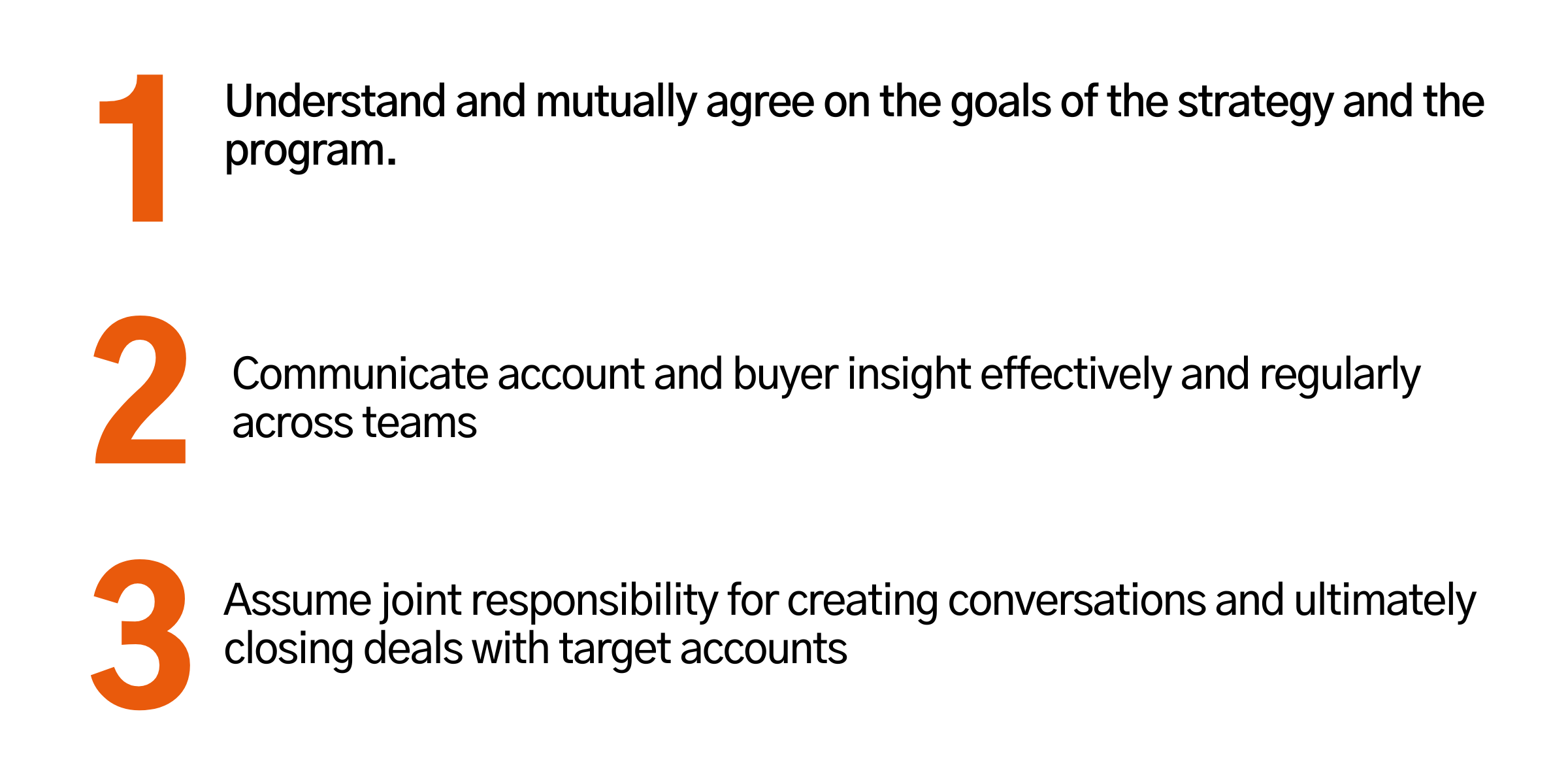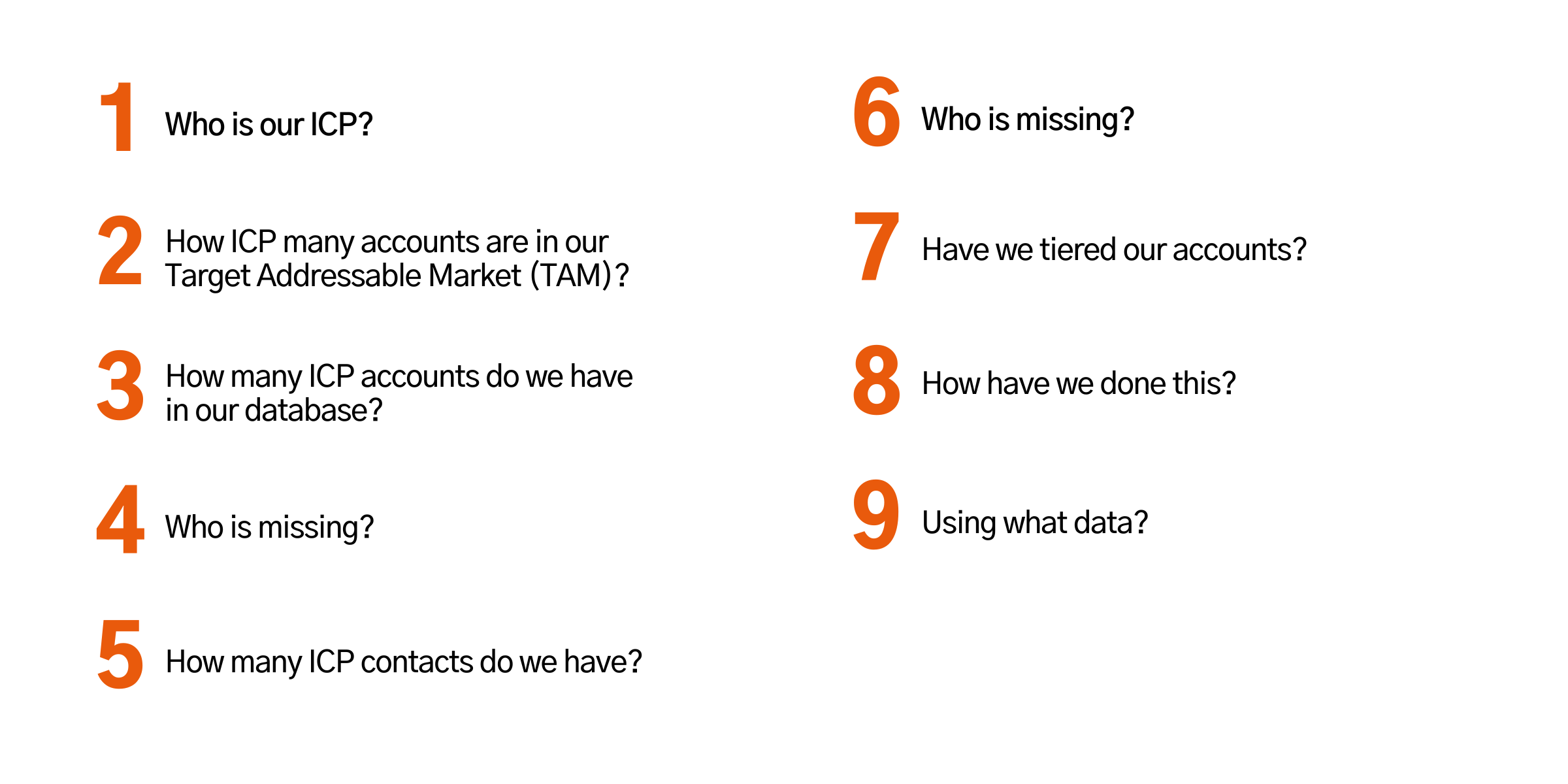It’s been said that ABM without Sales is just good Marketing.
And that’s what probably sets ABM apart from other Go-to-market strategies.
That deep alignment with Sales. That collaboration. That one-team approach. That singular focus on winning, growing, and retaining your most important accounts.
But when we asked the ABM community: “What is the hardest part of ABM?” They cited Sales and Marketing alignment as the hardest (or one of the hardest) parts of Account-based Marketing.
When you dig deeper and ask why:
- Educating and enabling Sales - Creating a more strategic mindset
- Aligning with Sales - As a marketer, switching to a Sales mindset
- Managing Sales’ expectations - Getting their time, focus, and meeting their demand
The fact that it’s hard doesn't mean it’s impossible.
.png?width=920&name=Blog%20images%20-%20(1200%20%C3%97%20400%20px).png)
So while it may be hard. It is certainly worth it. It is certainly rewarding. It is what makes the difference and moves the dial.
The important role of Sales in ABM
ABM as we know is best suited for engaging mid-market and enterprise companies.
The solution or product you are looking to introduce is invariably complex, of high consideration, with a long sales cycle, and a large group of interested parties involved in the review and purchase. Now we know that the buyer has changed beyond all recognition.
Today’s buyer is self-educated. Today’s buyer is informed. Today’s buyer has a wealth of information at their fingertips: reports, blogs, review sites, display advertising, podcasts, white papers, etc. The list is endless.
But, there is a problem. This ‘excess’ of information is causing a problem for buyers. There is now so much information that buyers actually need help to make sense of it all.
%2c%20low-regret%20purchase..png?width=1200&name=Customers%20who%20report%20overwhelming%20amounts%20of%20information%20are%2054%25%20less%20likely%20than%20others%20to%20make%20a%20high-quality%20(premium%20price%20point%2c%20large-scope%20solution)%2c%20low-regret%20purchase..png)
That is the modern-day role of Sales. To build those strong relationships with current and future customers and help them to simplify their product research - what has been termed ‘Sensemaking’ by Gartner.
If we reflect on where ABM is best suited - complex, high-consideration, long life cycle products and solutions - you can see that the modern role of Sales is paramount.
Sales and Marketing in partnership
Sales builds alignment between the vendor and buyer, through the development of Problem-Solution Fit, by understanding the needs of the buyer, helping to visualize, account for, and transition to a new way of doing business.
Often, this is driven as much by emotion as it is by logic, so Sales needs the support of Marketing to ensure that the buyer’s needs are met at commercial, solution, and emotional levels. Just as Marketing needs Sales insights from working at the coalface and to execute a joined-up buyer experience.
Ultimately, Sales and Marketing are driving towards the same goal of improving and increasing their company’s Reputation, Relationships, and Revenue.
ABM helps to solidify and make this shared goal more obvious, by providing a ‘North Star’ to point towards - the North Star of Accounts.
ABM is a strategic initiative that requires both parties to:

Everyone reading this will agree that it makes good sense that:
- Sales and Marketing need to align to make ABM a success.
- ABM makes it easier for these teams to align, over and above other marketing strategies.
Educating and Enabling Sales
This is one of the ‘hardest parts’ of ABM according to Amber Bogie, Director of Global Demand Generation at Reachdesk.

The first step we recommend any company starting their ABM journey is to define what problem they are trying to solve.
- Is it a revenue problem?
- Is it a pipeline problem?
- Is it a perception problem?
This problem identification process needs Sales (and indeed the wider organization) to be involved from the start. Even before an ABM strategy is introduced as a potential solution to these ‘ills’.
So what is the best way to get that sought-after Sales and Marketing alignment?
We’ve broken them down into what you can do today (Immediate Actions) and what requires a little more planning and time (Mid-long term Actions)
"It really is a challenge to try and explain a strategy that's not starkly different from what salespeople are really already doing." – Amber Bogie, Director of Global Demand Generation at Reachdesk
Immediate actions
1. Agree what problem you are trying to solve
- Sit down with your VP of Sales
- Review your GTM strategy (and results)
- Agree what problem you need to solve together
- Document it
- Present it back to a wider audience to get them all on your side
- Explain what will happen next (and give clear timelines)
2. Run ABM awareness workshops for Sales
Run ABM onboarding sessions with your Sales team to:
- Provide an overview of what ABM is (our ABM Playbook can help you here)
- The strategic reason as a business you are adopting ABM (the problem you have identified in point 1)
- Outline the benefits that this ABM program will have for them
- Clearly define roles, responsibilities, and expectations
- Name internal points of contact for all Account-based activities
3. Start with a clean slate
- Various stakeholders may have been involved in other ABM initiatives or programs previously
- Reset expectations
- Communicate a clear ABM framework for a new program
- Here is our ABM Framework to get you started
4. Use clear language
ABM often requires a shift in language. For example, instead of MQLs and SQLs (Marketing or Sales Qualified Leads), you should measure:
- MQAs (Marketing Qualified Accounts)
- SQAs (Sales Qualfied Accounts)
- SQOs (Sales Qualified Opportunities)
- One of the first steps to building a successful ABM program is building your ICP (Ideal Customer Profile) - does the Sales team know what this means?
- Avoid frustration and miscommunication, when sharing and educating Sales on your ABM framework
- Include language changes and any terms, phrases, or concepts they are likely to encounter, our ABM Glossary can help here
5. Start a social movement
- If your Sales team is not active on social media (particularly LinkedIn), introduce the concept of Social Selling at the start of your ABM program
- Provide training on why this is important to ABM and help them get their profiles up to scratch
- If any individuals express a paricular interest in becoming socially active, concentrate on helping them do so - they will become your Social Selling champions and help convert Sales colleagues to thinking in the same way
Share success stories of Sales engaging and winning via social. Here’s why Social Selling is so important for ABM
Mid-long term actions
1. Make ABM training a regular feature
Regular internal ABM training and knowledge-sharing sessions are a great way for teams to learn from each other. Book these in advance to keep consistency, invite team members to share their learnings, and encourage open and honest discussion.
2. Document everything
Ensure that you build a repository of ABM information, frameworks, and processes so you can optimize and train based on data and insights.
3. Build an ABM Center of Excellence
Both of the above will form the basis for an ABM Center of Excellence. This will be an ongoing project but capturing and documenting learnings as you go along will help if you need to scale the program across teams, regions, etc.
4. Create Account Playbooks
Once initial education is done, and the program is underway, create Account Playbooks for Sales to help them get to work on engaging with accounts more quickly.
Account playbooks should give salespeople all the information they will need about the account, in one place. If the salesperson is already familiar with the account, ask them to review the content against what they already know and include this insight, too. This way it is an Account Playbook useful for all teams.
Include details such as:
- Publicly available details of the account - website, social profiles, videos etc.
- A map and relevant details of the decision-making unit - names, job titles, LinkedIn profile, mutual connections etc.
- An overview of the strategy for that account, including access to any specific messaging and creative created for the account, including information on how to use it
5. Advanced Social Selling
More advanced Social Selling training (including how to use Sales Navigator if they have access to the tool). Some Salespeople may already be doing it, but provide training on how to find conversation starters and ‘hooks’ on prospects' social media profiles and activity. This can be an important part of getting to know key decision-makers within target accounts.
Aligning with Sales
Yes, ABM certainly helps Sales and Marketing alignment but it requires work from both sides.
Marnie Giuranna Zaccaria, Global ABM Lead at Finastra identified an important point; for ABM to work, Marketing needs to adopt a Sales mindset.

Marnie wasn’t the only ABM leader who flagged ‘aligning with Sales’ as the hardest part of ABM.
Check out the videos below where Danny Nail, Andreas Villumsen, and Becks Powell also identify the Marketing-Sales relationship as something that can be challenging.



Immediate actions
1. Develop ICP and Account Selection
- Confirm your ICP and account selection framework(s).
- Bring Sales along for this ride. Sales are at the coalface so their knowledge is invaluable.
- Involve Sales in building and validating your ICP and developing your account selection framework - this will strengthen your alignment.
2. Define objectives and set goals
- Define your commercial objectives
- Define your ABM program objectives.
- Share these objectives openly with your Sales team so they know exactly what you and the business are working towards.
- Encourage their feedback and open it up to be a two-way discussion. They may have existing insight into accounts that could affect these objectives and it’s useful to uncover this at the start so you can adapt if necessary.
3. Identify ‘North Star’ metrics
- Identify and share ‘North Star’ metrics.
- What specific metrics will you be using to measure the success of the program?
- Which team is accountable for which metrics?
- Are there metrics that individuals will be measured on? If so, share these with the appropriate party, explain why, and the process that will be in place for achieving these metrics. Not sure where to start with metrics? Here’s our guide to measuring ABM.
4. Get your data prepared
Align all parties around the most important part of ABM - Accounts. Define and validate your ICP as the first step to creating your Account Selection process. So you need as much insight from across the business as possible. Sales’ insight is invaluable here. Start by looking at Account-level data:

This TAM (Total Addressable Market) data is your ABM marketable universe.
Mid-long term actions
1. Find your ABM Sales Champion
If you’re struggling to engage some members of the team, identify an ‘ABM Sales Champion’ - someone who is fully bought into the process that can share their success with the program
2. Implement weekly communication
Regular communication is key. Weekly communication is a good benchmark for ensuring that all internal stakeholders are aligned and driving towards the right goals, whilst identifying any blockers and challenges.
3. Run ABM Lunch & Learns
Consistently deliver ABM Lunch & Learn/ internal knowledge shares. There is crossover here with the education piece, but it’s relevant here too. Over time your program is likely to evolve - even the best-laid plans change. It’s really important to keep Sales in the loop to any strategy or tactic pivots to avoid confusion and ensure everyone knows where to focus their efforts.
4. Celebrate ABM wins
Celebrate Sales ABM wins in these knowledge-sharing sessions. It’s important to recognize the impact Sales are having, and likewise, this regular communication should help to build trust so Sales respect and engage with the work Marketing does as part of the program. Create an ABM Slack campaign to get the message out.
5. Build ABM reporting framework
Develop and build a reporting framework (for example the ‘Three Rs’ framework) that aligns teams and delivers clarity on program maturity, timeline, and outcomes.
The short-term tactic is to set and share your ‘North Star’ metrics, the mid-long term goal is to regularly report against these metrics and share results so all stakeholders know how successful the program is.
Communicate these often, don’t wait until there is a problem or assume success will be continuous. To be agile, all teams need a clear view of these metrics.
How to manage Sales’ expectations
One of Elise Miller’s (Head of ABM, EMEA at ServiceNow) ‘hardest parts’ was around managing Sales’ expectations and “Generating enough supply to meet Sales’ demand when they see the program is doing well”.

So, how do you keep Sales on-side, meeting their demand of the program whilst also sticking to your ABM framework? A lot of it really comes down to the education and alignment pieces mentioned above, but here are a few additional pointers.
Immediate actions
1. Define the account selection framework
Make sure Sales understand (and agree with) the account selection framework and process.
This is really the key to managing Sales’ demand. If salespeople understand what qualifies an account to be enrolled in each program (One-to-many, One-to-few, One-to-one), there’s no confusion about what accounts can or should be included. The account selection framework may evolve, this is natural, just keep including Sales in this conversation.
2. Create an SLA with Sales
Use an SLA to stipulate roles and responsibilities for the program. Your SLA can also include things like AQL acceptance criteria and AQL follow-up process. The key here is to remove ambiguity.
Review the Three Rs of ABM. Educate sales and get alignment: E.g. Reputation - do we have a brand/proposition awareness issue? If so, do we need to solve for this first? What would that look like? E.g. thought leadership content such as our ‘Let’s talk ABM’ podcast series.
Define at what stage of the Three R's your program should start (this may differ by program type and business objectives)
Mid-long term actions
1. Adopt asynchronous communication
Once initial education is done, the program is underway, and all stakeholders understand their roles and responsibilities, consider implementing a level of asynchronous communication to deliver reports and project milestone updates.
This way both teams understand they are not at the beck and call of the other. Allowing asynchronicity reduces demand on either team's time. Our advice is to overcommunicate - give more information and more often than perhaps you would normally.
2. Review your SLA
Revisit the SLA quarterly to evaluate what’s working and what needs changing. It can be useful to bring quantitative data and qualitative, real-life customer/account stories here to help inform this evaluation and make any changes insight-driven rather than opinion-based.
3. Capture all learnings
Add all learnings (good and bad) to a centralized ABM portal as part of the ABM Center of Excellence development.
This CoE can then be used as a reference point for Sales. Once you’ve created this portal direct all stakeholders here as their first point of reference when they’re looking for information or answers to frequently asked questions.









